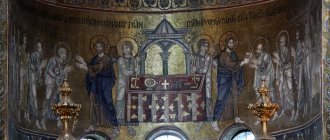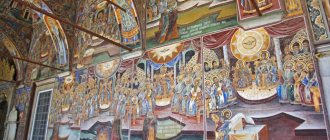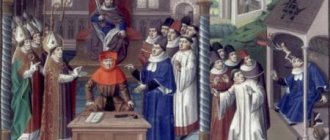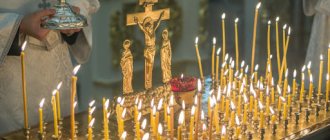VII Ecumenical Council of 787
Nicaea was designated as the location for the new convening of the council. A city not far from the capital, and yet it was not the capital itself, which was always seething and making palace coups. A city famous for its memories of the 2nd Ecumenical Council. Since the bishops of the previous convocation had left and the papal legates were already in Sicily, the empress in May 787 began sending out invitations throughout the empire to the former delegates for a new congress in Nicaea. The Pope responded with approval of this new convening of the council. In his letter to Charlemagne he writes in Western style: et sic synodum istam secundum nostram ordinationem (!) fecerunt.
Here is a sample of Western illusions about the meaning of the actions of the East.
The delegates were mostly the same: the same two presbyters Peter from Rome; the same formally covered representatives of the three Arab patriarchates - John and Thomas. The Romans signed first, then the Patriarch
Constantinople, and behind them are representatives of the other patriarchs, John and Thomas. The actual chairman and leader of the debate was Tarasius, O προκαθεμονος, as both Roman Peters call him. Irene and Constantine were not personally present at Nicaea. They were represented by: Comite (Count) Petrona and Chief of Staff John. Subsequently, Patriarch Nikephoros, in a letter to Pope Leo III, calls this council “the council of 350 fathers.”
Nikifor was a young secretary at the council and knew the state of affairs. The number of those present at the cathedral actually reached 350, and even 368. But the list of the maximum number of full-fledged signatories did not exceed 308. They made sure in advance that the cathedral was no less numerous than the iconoclastic council of 754, at which there were no less than 338 people. A feature of the cathedral was the attraction of many monks to it - πλαθυς μοναχων, who covered with 131 signatures the acts of the cathedral under the leadership of Sava, abbot Των Στουδίων, and Plato, abbot Σακκουδεών ος.
Although it is stated in the introduction to the minutes of the council that the monks, together with the imperial officials, were not decisive members - καθεσθέντες, ΰ only συμπαρόντες κai άκροώμενοι, but at the second meeting they decided that they had the right to vote. The monks asked themselves: do they have the right to cast their votes? And they received an affirmative answer through Tarasius that “such is the order that each of those present at the council votes his conviction, εκφωνειν την εαυτου ομολογιαν.”
Thus, the monks were “in their rank,” but with the right to vote. Even at the “Robber Council” of 449, Dioscorus summoned the Syrian Abba Bar-Tsauma (Varsuma), and he fully signed his acts. At the IV and V councils, monks were not invited to become members of the councils. At VI there were 6 of them, but here there are already a ton. This is proof that participation in the council and law in the church are born from moral strength. At the Apostolic Council, chaired by the Apostle James, all the brethren participated “in their rank,” i.e. absolutely everything, for “all believers had one soul.” So now the cathedral and the monks who confessed the icons “had one soul.” Thanks to the participation of many monks in the council, approval of his actions was ensured throughout the entire thickness of church opinion.
There were 8 meetings of the council in total: the first - in Nicaea (in the Church of St. Sophia) on September 24, 787 and the last - in the presence of emperors in Constantinople on October 23. Thus, the council was relatively short. According to custom, the gospel was placed in the middle between those sitting. Only at the fifth meeting, at the suggestion of the Roman legates, was it decided to bring an icon and venerate it the next time - they had become so unaccustomed to the use of icons.
Tarasius opened the meeting of the council with a short speech and invited everyone to the same brevity.
We began with the question of admitting into communion bishops who had become entangled in iconoclasm. The question is interesting in the sense that for the first time we see a formally canonical study of it based on ancient models in the setting of an ecumenical council. Antiquity resolved the issue more simply, in the spirit of church teaching. This is where history and archeology come into play. Moreover, the decision was complicated by the fact that the presence of two clearly expressed trends was revealed in the cathedral. Tarasius embodied one thing: a moderate, condescending trend that sought civil and ecclesiastical peace. These people of state interest and state experience understood the historical and psychological nature of iconoclasm as a contagious social experience and passion. They understood that it had to be overcome gradually and not without compromise
in relation to individuals. This trend was guided by Byzantine “oikonomia,” or, more roughly, by politics.
The other was embodied in monks. They were only interested in the church side and zeal for the purity of the canons. The cutting off of sick members seemed absolutely necessary to them. Tendency to treat the sick with the help of the healthy
they didn't have. With these disparate tendencies in agreement, the question itself was treated with meticulous rigor.
The bishops tested were divided into three categories. The first one included the most “easy” characters to solve. In the second - more difficult and in the third - even more difficult. The subjects, apparently, did not at all come here voluntarily, for the technical term says that they were legally “brought in - προσηχθησαν, παρηχθησαν.” The responsibility was imperial power. But they were not arrested and entered the cathedral when summoned without bailiffs, except for the bishop from the last category.
At the very first meeting, three bishops of the first degree were introduced: Basil, Metropolitan of Ancyra, Theodore, Metropolitan of Marlycia, and Theodosius, Bishop of Ammoria (Phrygia). The judgment about them, apparently, was so favorably prepared that they only listened from their lips to the reading of their λιβελλοι, ς.e. statements of repentance, and they were immediately accepted into their existing rank and seated in their chairs at the cathedral. The repentant statements of these bishops consisted of confessing their mistakes. Theodosius of Ammoria, for example, admitted that, being mistaken, he spoke a lot of bad things about revered icons. And now he spoke positively and more definitely: “As for the image in churches, then, I believe, first of all, depict the icon of the Savior and the Mother of God from any substance: gold, silver or various paints; so that the economy of salvation may be available to all. I also consider it useful to depict the lives of saints, so that their works and exploits are known to the people, especially the common people, briefly outlined in their consciousness and taught to them. If the royal portraits and figures sent to cities and villages are met by people with candles and censers, showing respect not to the image on a wax-drenched board, but to the emperor himself, then how much more should the icon of the Savior, His Mother and saints be depicted!” One of the bishops, after hearing such a speech, even exclaimed: “The speech of the venerable Bishop of Ammoria even brought tears to our eyes.”
Moderates through the mouth of Tarasius simply stated that “those who were once accusers - κατηγοροι of Orthodoxy, have now become its confessors - συωηγοροι. Theodosius showed great contrition of heart!” The monks also agreed with this, but asked to note in the protocols that in this case they accept those who repented as “converts from heresy - τους εξ αιρεσεως επιστρεφοντας.”
Following this, 7 bishops of the second degree were introduced to the same first meeting: Hypatius - Metropolitan of Nicaea, Leo - Metropolitan of Rhodes, Gregory - Metropolitan of Pissuni (Galatia); Leo - Metropolitan of Iconium, George - Metropolitan of Antioch of Pisidia; Nicholas - Bishop of Hierapolis; Leo is the bishop of the island of Karpathos. Judgments about them dragged on and were postponed to the next meeting.
It was these bishops who were accused of holding special agitation meetings (παρασυναγωγας) in Constantinople last year and disrupting the council. Now they declare that from reading the holy fathers they were convinced of the truth of icon veneration, and last year they acted “out of ignorance and unreason - κατά αγωοιαω και αφροσυνην.”
This admission of ignorance on the part of bishops, and even active rebels, was rather strange. Was their appeal sincere? Tarasius himself posed rather skeptical questions to them. To Leo of Rhodes: “Well, how is it that you, my father, have been a bishop for eight or ten years and are only now convinced?” Those interrogated explained the matter by habit and the new upbringing that had been created: the new teaching had long since taken root and they took it out of school. Tarasy remarked, not without causticism: “The more difficult it is to cure chronic diseases.” And “it is not beneficial for the church to accept clergy from bad teachers.” To this, Hypatius of Nicea remarked: “And yet conscience prevailed!”
It seemed to Tarasius that repentance was enough. And Savva the Studian believed that God led these bishops to the path of truth. But the representative of the “eastern” John stated that it was still difficult for them, the monks, to resolve the issue, because it was not clear: according to what standard should these persons be received? Is it with the right of the priesthood and in the existing rank?
Start reading the rules:
Apostolic - 51, Nicene - 9, Ephesian - 3 (2, 4), Basil the Great to Amphilochius - 188, Basil's letter - 251, 263, 99, 240, Council of Ephesus on the Messalians, Cyril of Alexandria letter - 57, 56, St. Athanasius to Rufinian, examples from the “History” of Socrates, Theodore the Reader, from the Acts of Chalcedon, from the life of St. Savva - about the acceptance of those appointed to the priesthood by heretics.
All the data pointed to acceptance. But the return of episcopate rights could be debated depending on the degree of participation in iconoclasm, i.e. on the degree of heresy. Bishops from Sicily (and there were many of them at the council from among the Greek monastic emigration), through the mouth of their learned deacon Epiphanius of Catania, proposed to identify the new heretics with some previous heresy and then draw conclusions. Epiphanius asked: “Is the newly invented heresy less or more than the previous heresies?” Tarasius said: “Evil is evil,” i.e. was inclined to equate heresies. Monk John, Deputy Patriarch of Antioch, strengthened his qualification: “This heresy is the worst of all heresies, as it overthrows the economy of the Savior.” A number of paternal opinions and historical analogies spoke in favor of moderation. Thus, Basil the Great considered it fair to rebaptize the Encratites, but did not want to scare them away from the church and did not object to those cases when some Encratites had already been accepted into the existing episcopal rank. The Third Ecumenical Council decided to accept the Messalians in their existing rank. Cyril of Alexandria advised zealots not to find fault with the repentant Nestorians, “for the matter needs great economy.”
But the monks liked the letter of St. more. Athanasius to Rufinian. It sets out his practice, established by the Council of Alexandria in 362 in relation to the Arian clergy: to forgive “the leaders of wickedness”, but not give them a place in the clergy, “and those lured by need and violence” to forgive and admit to the clergy. The monks asked this question to the subjects: can it be said about them that they were drawn into iconoclasm by violence? Hypatius of Nicaea completely rejected this. He said: “After all, we were born, raised and revolved around this heresy all the time.”
Later it was recognized that these bishops cannot be recognized as teachers of heresy (they are heretics, so to speak, by inertia) and therefore they can be accepted into office. But if they are insincere, then God will be their judge.
The monks also had to be convinced by a number of examples about the acceptance of heretics in their existing rank: Marcellus of Ancyra, and at the IV Ecumenical Council - Juvenal of Jerusalem, Thalasius of Caesarea-Cappadocia, Eusebius of Ancyra, Eustathius of Virita. The consecration of heretics was also recognized: Meletius of Antioch was ordained by the Arians, Cyril of Jerusalem - also by Acacius of Caesarea and Patrophilus of Scythopolis - ardent Arians; Anatoly of Constantinople - Dioscorus, John of Jerusalem - Sevirians, most of the fathers of the VI Ecumenical Council - Monothelites.
The monks referred to the 240th letter of Basil the Great, where he writes: “I do not recognize as a bishop and would not consider one of the priests of Christ nominated for primacy with unclean hands to destroy the faith.” Therefore, those consecrated by him should not dare to “rank themselves among the priestly pleroma.” “Here,” the monks said, “the holy father rejects the consecration of heretics.” Patriarch Tarasius explained that here Basil the Great does not say that such people are generally unacceptable, but only that they should not unconditionally demand entry into the Orthodox clergy, as if by right. The practice under Basil the Great was explained by the circumstances of the time. “And Basil’s successors in the church of subsequent times, of course, knew the opinion of the holy father and nevertheless accepted the repentant with their consecration from the heretics.”
Finally, everyone recognized the question as correctly explained ακριβως εξετασθεν, they began to read the penitential statements to the subjects and accepted them in their rank at their pulpits.
The third class of defendants was represented by only one Metropolitan Gregory of Neocaesarea. He was already literally “brought” under the escort of the “royal man” - μανδατωρ, who, introducing Gregory into the cathedral, declared: “I was sent by the Blessed Sovereigns to bring the most venerable bishop of Neocaesarea to your godly and holy council, before which I stand now.” Gregory was not accused of last year's riot, but he was an old iconoclast, a participant in the council of 754 and, apparently, was one of the stubborn ones. However, he also appeared before the cathedral with a willingness to be convinced and understand the point of view on icons that was still unusual for him - θρλω μετα παντων και φωτισθεναι και διδαχθηναι.
The unanimity of the council made a great impression on him, and he asked to be forgiven.
Two doubts about the possibility of Gregory's ordination were clarified. Tarasius recalled that Gregory served as bishop under Constantine Copronymus during the persecution. Then bishops could be involved in the beating of pious icon-venerators, and for beating others, clergy were deposed according to the 26th and 28th Apostolic Canons. But Tarasius made a reservation: no one should be accused without factual evidence. Gregory himself decisively declared: “Not a single person will dare accuse me of beating or hitting anyone. No one suffered such an insult from me.” Savva the Studite asked: “Gregory was considered a representative of heresy - εξαρχον της αιρεσεως? Will he not have to be judged according to the rule of St. Athanasius in his letter to Rufinian, as the leader of heresy? Tarasius objected to this with facts: Juvenalius of Jerusalem and Eustathius of Sebastia were leaders of the heresy (εξαρχον αιρεσεως) and, however, were accepted. Finally, Gregory was returned to his department.
* * *
From the fourth meeting, the analysis of biblical, theological, patristic and historical data in favor of icon veneration began. Without going into details, we will only note a few thoughts of the council, which it contrasted with the ideology of the iconoclastic council of 754.
After biblical data (cherubim of the tabernacle and temple), the cathedral proved with quotations from the fathers the psychological naturalness and value of icons in religion. On this path, the council very carefully rejected the hypocritical and false argument of the iconoclasts, directed against art in general in the field of religion. The Council reasoned: “This means that the art of a painter is a sacred occupation and is not at all such as to be ridiculed.” - “The Holy Fathers represent the painter as a person doing a pious work.” – “And what strange conclusions will we come to if, like the iconoclasts, we reject religious art? Does this mean that a carpenter who carves a cross should also be called a miserable carpenter? And the mason who carves and shapes the holy table is also a miserable mason? And goldsmiths, silversmiths, and weavers too? Shouldn't they, in their opinion, abandon all knowledge and art given by God for the sake of His glory?
.
Don’t the iconoclasts really know that God Himself
sanctified art
in the Old Testament , commanding Beseliel to prepare all the necessary decorations for the Tabernacle?”
As we have already said about the council of 754, its sanctimonious campaign against art rejected in principle all knowledge, and all theology, and all human thought and word, as tools for the expression of dogmas
.
This was not only hypocritical feigned barbarism, but also simply dualism, rejecting the holiness of all material things. The Seventh Council Orthodoxy rebels against this hidden heresy of Monophysitism
and dualism and defends, along with art, “all knowledge and art, as given by God for the sake of His glory.”
The Enlightenment liberalism of the iconoclasts thus turns out to be obscurantism, and the theology of the VII Council is a blessing of science and culture, the most profound and indisputable.
The most common expression of iconoclasts against “man-made” icons is a reference to the image of the Eucharist, which the council also victoriously rejects: “Not one of the apostles and evangelists anywhere calls the bloodless sacrifice an image of the flesh of Christ
. If some fathers, for example, Basil the Great and Eustathius of Antioch, call the bloodless sacrifice - bread and wine - “substitute”, then they call it that way only until the moment of their transformation into the true Blood and Flesh of the Lord. To teach as the iconoclasts teach means to deny the transfusion of the Holy Gifts.”
The cathedral also clarifies the image of veneration of icons: is it only respectful, reverent kissing
or also
worship
?
The Council precisely established that not only kissing, but also worship
is προσκυνησις,
but not
λατρεια, ς.e.
service
befitting the divine nature alone.
For clarification, they referred to one passage from St. Anastasia, Bishop of Theopol: “We worship
both holy people and angels, but
we do not serve them
as gods, for Moses says: Worship the Lord your God and serve Him alone.
Look, with the word “serve” the “One” is added, but with the word “bow” it is not added. This means that worship
someone other than God, because worship is an expression of respect,
serve
anyone but God.”
Remembering the abuses of the council of 754 with torn quotations on individual “fiches” (πιττακια, cards), the VII council meticulously followed the form of reading all quotations from the brought complete books. When Presbyter Elijah of Blachernae began to read the rule of the Trullo Council according to the charter, Savva the Studian directly asked him why it was not being read according to the book. Then Tarasius explained that this charter in this case constitutes the original of the acts.
Several other details are also not without historical interest.
At the third meeting (September 28), the bishop of the city of Constantia in Cyprus, Constantine, put it this way (“and others agreed with him”): “I accept and kiss the holy icons with deep reverence, but as for worship in the sense of service
(προσκυνησις κατά λατρειαν), but I give it exclusively to the Holy Trinity.” The Frankfurt Council of Charlemagne in 794, hostile to Byzantium and ignorant of the Greek language, interpreted this correct formula just the opposite, as if the Council of 787 attributed to the icons precisely adorationem - λατρειαν, veneration in the sense of service, which is appropriate only to the Holy Trinity.
At the fourth meeting (October 1), Patriarch Tarasius, referring to the 82nd rule of the “Fifth-Sixth” Trullo Council, called it a council of the same fathers of the VI Ecumenical Council, and the papal legates signed this protocol, as if not considering it to be contrary to the fact of rejection Roman church of Trullo Cathedral.
At the seventh meeting (October 13), before its meeting, the VII Council cites the text of the Nicene-Constantinopolitan symbol, of course, without fïlioque. When, at the Council of Florence on October 16, 1438, the Latins showed the Greeks the Greek manuscript of the acts of the VII Ecumenical Council with the insertion of the words “και εκ του Yιού,” Gemistus Plito correctly objected to them that if this had been written from the beginning since the VII Council of 787. , then Latin theologians, such as the great Thomas Aquinas, would not have cited a number of other writers and minor councils in their polemics with the Greeks to “shame” them. Therefore, this manuscript is interpolated.
* * *
The final oros of the council, read and adopted at the 7th general meeting (October 13), had the following form:
“And to put it briefly, we keep all church traditions
, established for us in writing or without writing.
One of them
is an image in icon painting, as consistent with the story of the Gospel sermon, serving us as evidence of a genuine, and not a ghostly, incarnation of God the Word; for things that mutually point to each other, without a doubt, clarify each other.
Therefore, we, walking as if in a royal way and following the divine teaching of the holy fathers and the tradition of the Catholic Church and the Holy Spirit living in it, determine with all care and prudence:
like
to the image of the honest and life-giving
Cross
, to place in the holy churches of God, on sacred vessels and clothes, on walls and on boards, in houses and on paths, honest and holy icons, painted with paints and made from mosaics and from other suitable substances, icons Our Lord and God and Savior Jesus Christ, our immaculate Lady, the Holy Mother of God, also the honorable angels and all the saints and reverend men.
For the more often they are visible through the image on icons, the more those who look at them are encouraged to remember the prototypes themselves and to love them.
and to honor them with kisses and reverent worship
(τιμιτικην προσκυνησιν), not by that true
service
(λατρειαν), which befits the Divine nature alone, but by veneration according to the same model, as it is given to the image of the honest and life-giving Cross and the Holy Gospel, and other shrines, fimi amom and lighting candles , as it was done according to pious custom and by the ancients.
For the honor given to the image goes back to the prototype, and the one who worships the icon worships the hypostasis of the person depicted on it.
This is the teaching of our holy fathers, i.e. the tradition of the Catholic Church, which has accepted the gospel from end to end of the earth.
Those who dare to think or teach differently or, in agreement with the wicked heretics, to reject church traditions and invent some kind of innovation or reject something dedicated to the church, the Gospel or the image of the Cross or an icon painting or the holy remains of a martyr, or to plot something with cunning and deceit to overthrow any of the traditions accepted in the Catholic Church or to give profane use to sacred vessels or holy monasteries, we decree:
if they are bishops or clergy, they will be defrocked; if they are monks or laymen, they will be excommunicated.”
So here are the following:
the basis for the veneration of icons is the tradition of the church, as an indisputable model, the veneration of the cross, the place where icons are supposed to be depicted, materials for holy icons; objects of the image, the moral meaning of veneration, its dogmatic norm, church punishments for the disobedient.
Having signed the protocol, the fathers exclaimed: “Such is our faith, such is the teaching of the apostles! Anathema to those who do not adhere to it, who do not honor icons, which they call idols and accuse Christians of idolatry for them. Long live the emperors! Eternal memory to the new Konstantin and new Elena! May God bless their reign! Anathema to all heretics, Theodosius - the false bishop of Ephesus, Sisinius Pastilla and Basil Trikokav. Anathema to Anastasius, Constantine and Nikita, who were successively patriarchs of Constantinople. They are Arius II, Nestorius II, Dioscorus II! Anathema to the heresiarchs John of Nicomedia and Constantine of Nakolia! Eternal memory to Herman (Constantinople), John (Damascus), George (Cyprus) - these heroes of truth! These three were anathematized by the Iconoclastic Council of 754.
By a special order given to Tarasius, the emperors invited the members of the council to come to Constantinople. The Empress kindly received them and scheduled the last, 8th ceremonial meeting at the Mangavra Palace for October 23. At this meeting, in the presence of the emperors, officials of the empire and the army, the definitions of the council were read, confirmed by exclamations of approval from everyone, including the military, and signed by the emperors, starting with Irene. After this, the bishops, bestowed with gifts by the queen, were dissolved into dioceses. Irina ordered in advance to make an image of the Savior over the gates of Chalcopratia, from where he was overthrown 60 years ago under Leo the Isaurian. Now an inscription was made to it: “ην καθειλε πάλαι Λέων ό δεσπόζων, ενταύθα άνεστήλωσεν Ειρήνη.” There is a play on the words “Leo” and “Irina”. Judging by the term, “άναστηλόω” the image was sculptural or simply a cross with a crucifix.
The Council issued 22 more canons, mainly against simony and disorder in the life of monks.
First attempt to open the Council in 786
The opening of the Council was scheduled in Constantinople on August 7, 786. The iconoclast bishops who arrived in the capital, even before the opening of the Council, began to negotiate in the garrison, trying to enlist the support of the soldiers. On August 6, a rally was held in front of the Hagia Sophia with a demand to prevent the opening of the Cathedral. Despite this, Irina did not change the appointed date, and on August 7, the Cathedral was opened in the Church of the Holy Apostles. When the holy scriptures began to be read, armed soldiers, supporters of the iconoclasts, burst into the temple:
|
The bishops supporting Irina had no choice but to disperse. Having survived the failure, Irina began preparing to convene a new Council. Under the pretext of war with the Arabs, the imperial court was evacuated to Thrace, and a garrison loyal to the iconoclasts was sent deep into Asia Minor (ostensibly to meet the Arabs), where the veterans were given their resignations and paid generous salaries.[6]Constantinople was transferred to the protection of a different guard, recruited from Thrace and Bithynia, where the views of the iconoclasts did not spread.[7]
Having completed preparations for the Council, Irina did not dare to hold it again in the capital, but chose for this purpose remote Nicaea in Asia Minor, where the First Ecumenical Council was held in 325.
Links
Eastern Church Trullo Cathedral | Fourth Council of Constantinople (Sophia) | Fifth Council of Constantinople | Jerusalem Cathedral | Pan-Orthodox Cathedral Western Church Fourth Council of Constantinople | First Lateran Council | Second Lateran Council | Third Lateran Council | Fourth Lateran Council | First Lyon Cathedral | Second Lyon Cathedral | Vienne Cathedral | Cathedral of Constance | Ferraro-Florence Cathedral | Fifth Lateran Council | Council of Trent | First Vatican Council | Second Vatican Council Robber Cathedrals Antioch Cathedral | Milan Cathedral | Ephesus "Robber" Cathedral | first Iconoclastic Council | Second Iconoclastic Council
Notes
- Kartashev A.V. Ecumenical Councils
Klin, 2004. P. 577 - Chronography of Theophanes
, year 6277/777 (784) - Kartashev A.V. Decree. op. P. 613
- Kartashev A.V. Decree. op. pp. 615—617
- Irina refused to grant this request from her dad
- Kartashev A.V. Decree. op. P. 622
- [www.roman-emperors.org/irene.htm Constantine VI (780-797 AD) and Irene (797-802 AD)] (English)
- Kartashev A.V. Decree. op. P. 619
- Kartashev A.V. Decree. op. P. 624
- [xerouveim.blogspot.ru/2010/01/blog-post_25.html η στο Φροντιστήριο Κατηχητών της Ι. 25η Ιανουαρίου 2010)]
- [gallica.bnf.fr/ark:/12148/bpt6k515954/f195.image Sacrorum conciliorum nova et amplissima collectio. Tomus 13 col. 378]
- [www.xxc.ru/orthodox/pastor/vii_sobor/index.htm Dogma on the veneration of icons of the Three Hundred and Sixty-seven Saints, father of the Seventh Ecumenical Council]
- Definition of the Holy Great and Ecumenical Council, the second in Nicaea ([relig-library.pstu.ru/catalog/1189/book-1189.djvu Acts of the Ecumenical Councils, published in Russian translation at the Kazan Theological Academy]. - Kazan: Central Printing House, 1909 - T. 7. - pp. 284–285. - 332+iv p.).
- The Russian translation is based on the book by A. V. Kartashev [azbyka.ru/dictionary/03/kartashev_vselenskie_sobory_10-all.shtml#s13 Ecumenical Councils]
- The inscription is based on a play on words Λέων - “lion”, a predatory beast and Ειρήνη - “peace, tranquility”
Literature
- Firsov E.V.
Acts of the Second Nicene (Seventh Ecumenical) Council (787). New edition. With polemical excerpts from Libri Carolini, published for the first time in Russian. - St. Petersburg: "Nestor-History", 2016. - 596 p. — 500 copies. — ISBN 978-5-4469-0891-2 - Prot.
Vladislav Tsypin [www.pravenc.ru/text/155500.html VII Ecumenical Council] // Orthodox Encyclopedia. Volume IX. - M.: Church-scientific, 2005. - P. 645-660. — 752 p. — 39,000 copies. — ISBN 5-89572-015-3








